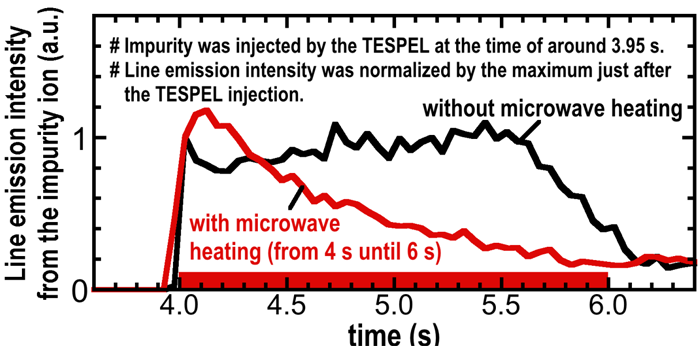HOME > Research Activities > Research Updates >
In order to achieve fusion energy it is necessary to maintain a plasma at a sufficiently high temperature for the fusion reaction to occur over an extended period of time. One issue in maintaining a high-temperature plasma is the control of impurities that enter the plasma core. Because impurities absorb the energy of a plasma and release that energy as light, as the amount of impurities increases the plasma temperature falls.
In the future fusion reactor, all elements will be impurities, with the exception of deuterium and tritium as the fuels. Impurities are generated from the wall and other places in the vessel that confines the plasma. After transferring energy to the plasma from the helium that bears high energy generated by the fusion reaction of deuterium and tritium, the helium becomes an impurity (helium which has lost its energy, or cinder, is called “helium ash”). Thus, in order to reduce the amount of impurities, not only must impurities not be introduced into plasma, it also is important to establish a method for expelling impurities from plasma.
At the National Institute for Fusion Science, in the Large Helical Device (LHD) by injecting microwaves, such as those used in a microwave oven, into a high-temperature plasma we have advanced in our development of a method for expelling impurities. Investigating whether we can effectively expel impurities from plasma is similar to investigating to what extent dirty clothing can be cleaned in the laundry. In the LHD, using the magnetic field structure in the edge region, we can readily produce a condition in which it is difficult for impurities to enter from the device wall. (For details please refer to the back number 262). On the other hand, the phenomenon in which impurities that have entered the core region of the plasma do not exit from the plasma and remain within the plasma has been observed. Using this phenomenon, we have purposely placed impurities inside a plasma and investigated the subsequent movements of the impurities. In this experiment, for impurities that typically get mixed in a plasma (iron, carbon, and others), there are subtle changes that are difficult to determine whether impurities are expelled or not. Thus, in order not to overlook the subtle changes, we decided to intentionally inject an impurity that typically would never enter a plasma. Using the TESPEL (for details please refer to the back number 227) developed in the LHD, we deliberately injected an impurity from outside. As the result of examining that impurity’s movements, after injection and doing little the impurities barely decreased and remained in the plasma. But in injecting a microwave into the plasma immediately after injecting the impurity, we discovered that the impurities, which were expected to stay in the plasma, rapidly and greatly decreased.
In this way, using microwaves we succeeded in effectively expelling an impurity from a plasma. In the future, in order to more efficiently expel an impurity from a plasma, it is necessary to advance optimization of the conditions for the injection of a microwave. Further, in order to establish this method using microwaves and to apply this to the future fusion reactor, it is important to clarify those principles that inform why impurities are expelled from a plasma when a microwave is injected into the plasma. It has been suggested that the electric field inside the plasma, about which we already know regarding the significant influence to the movement of the impurity, is possibly changed by the microwave. At present, we are verifying this through the two sides, theory and experiment. Through such research in the LHD, if we can establish control methods for impurities in a fusion reactor plasma, we can move one step closer to achieving fusion energy.

When impurities are injected into a plasma the impurities become ions and emit light. We investigated the time change in the strength of that light emission. In the case of not injecting microwaves (black line), the light emission strength from ion impurities shows almost no decrease until approximately 5.5 seconds (because plasma temperature decreases due to the light emission, after 5.5 seconds the light emission strength from the ion impurities too is decreasing). Conversely, when microwaves are injected (red line) immediately after the injection of impurities, the light emission strength from ion impurities rapidly falls. This result indicates that by using microwaves impurities could be effectively expelled from plasma.
